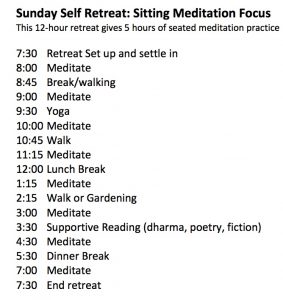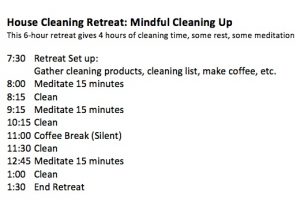The key to a good retreat is a good schedule. And when you self-retreat (as opposed to joining a formal retreat) you get to create the right schedule for you.
Whether the retreat is 3 hours or 3 days you’ll want to create a detailed schedule of activities so you can stay on track and not just drift off into “normal” daily life.
The Retreat Schedule is probably the most important tool in the self-retreat retreat toolbox. If you don’t have a retreat schedule, you may have no idea what to do next after that 1 hour 6AM sit. The schedule creates movement and momentum. It also gives you breaks.
It only takes a few minutes to create a schedule.
1. Start by choosing the Start Time and End Time of the Retreat.
2. Consider the following as you design the schedule:
- Your goals and/or retreat theme if applicable (see Designing Your Retreat).
- Remember you’ll most likely have at least one meal, unless your retreat is very short. Note that breaks and meals (and clean up after meals) are also part of your retreat. You are still in the retreat “container” keeping some mindful presence as you move from one activity to the next.
- Be sure to include some kind of movement practice (walking, yoga).
3. Write up and print your retreat schedule and tape it to a surface in your retreat space for the duration of the retreat.
Again, the key is sticking to the schedule as best you can because that schedule is really holding the whole thing together.
It’s exactly like when you set the timer to meditate. You don’t want to cheat yourself out of the time you set aside to meditate. You want to give yourself the spaciousness and support of that alloted time. Don’t siphon it off to the computer, the text message, the the bills, etc.
Retreat Templates
Here are three sample retreat templates for you to play with.
1. 8-12 hour – “Mindfulness Meditation Classic” (use for 1 day or for multi-day retreat)
2. 6 hour – Cleaning
3. 6 hour – Relaxed/Project Focused
Finally, below is the structure I set up for myself to move this website forward today.
Kerry’s “Work on the Website” Project Retreat
8:30 20 minute meditation
9:00 Website
10:15 15 min Yoga/Sit
10:30 Website
11:00 Walk
12:30 Lunch
1:00 30 minute meditation
1:30 Website
3:00 30 min Garden (weeding)
3:30 Website
4:00 30 min meditation
4:30 15 min review website and next steps
4:45 15 min walking meditation
5:00 End retreat
This one mixes it up. I decided today to focus only on getting out my first draft of this website, however friends are in town and we have plans to go on a walk this morning. So, strictly speaking, not a self retreat. But I’m still going to use the parameters of the retreat to structure my mostly silent day.
Retreat Parameters: Mostly silent and mostly focused on my work project. No news. No email. The intention for this retreat is to treat this focused work time as a retreat. It’s not just bringing mindfulness to my work, it relaly has to do with weaving in the bits of meditation throughout which I’ve found very helpful in the past, especially since yesterday I was so tense.
 Elements incorporated here: staying focused on one task, meditation, embodiment, movement, unplugged from news, unplugged from email/random internet.
Elements incorporated here: staying focused on one task, meditation, embodiment, movement, unplugged from news, unplugged from email/random internet.
“Kerry’s New Moon Self Retreat”
This is what I used for my four hour retreat (see blog) on March 24, 2020.
8:00 45 minute meditation
9:00 Neighborhood Walk
10:00 45 minute meditation
10:45 Read or Write
11:30 30 minute meditation
12:00 Lunch/End Retreat
I needed to work in the afternoon, but wanted a few hours of silence. I was mostly interested in three things: meditating, being in silence, and staying unplugged. This is actually a quite spacious example of a “retreat.”
You’ll also notice I made the 11:30 slot a 30 minute meditation rather than 45 minutes. Knowing I was heading into lunch (and out of the retreat) I opted to keep that one shorter – it just intuitively felt more supportive than a third 45 minute sit.